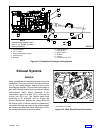
TP-5695 12/936-12 Installation
A typical silencer should be mounted no more than 4 ft.
(1.2 m) below the highest point in the exhaust line.
Attach a separate wood mounting base to hull stringers
or other suitable structure. Then secure the silencer to
hull using silencer manufacturer’s recommendation. Be
sure the silencer outlet is not more than 10 horizontal ft.
(3 m) from the engine exhaust manifold outlet. UL
marine exhaust hose should be used.
Electrical Systems
AC Voltage Connections
WARNING
Explosion.
Gasoline vapors can cause explosion and
severe injury or death.
Before starting generator set, operate blower 4
minutes and check engine compartment for
gasoline vapors.
Explosive fuel vapors can cause severe injury or
death. Gasoline vapors can explode and can cause
death or severe injury. USCG Regulation 33CFR183
requires all electrical devices (ship-to-shore transfer
switch, remote start panel, etc.) to be “ignition protected”
when used in a gasoline (gaseous)-fueled environment.
These electrical devices are not “ignition protected” and
are not certified to operate in a gasoline
(gaseous)-fueled environment such as engine room or
near fuel tanks. Acceptable locations would be
wheelhouse or other living areas sheltered from rain and
water splash.
WARNING
Hazardous voltage.
Do not operate generator set without all guards
and electrical enclosures in place.
Moving rotor.
Can cause severe injury or death.
Hazardous “backfeed” voltage can cause severe
injury or death. Do not connect to any building/marina
electrical system without connecting through an
approved device and after building main switch is open.
Backfeed connections can cause serious injury or death
to utility personnel working to repair a power outage
and/or personnel in the vicinity. Unauthorized
connection may be unlawful in some states and/or
localities. A ship-to-shore transfer switch must be
installed to prevent interconnection of generator set
power and shore power.
AC connections to generator set are made inside the
controller box. The generator set is usually connected to
a ship-to-shore transfer switch which allows the use of
shore/utility power when docked or generator set power
when docked or at sea. The wiring is then connected to a
main circuit breaker box (panelboard) which distributes
branch circuits throughout the craft. See Section 5.
Wiring Diagrams for reconnectability of generator set.
Installation in Steel or
Aluminum Vessels
Installation of a generator set in a vessel constructed of
a material capable of conducting current (e.g.: steel or
aluminum) is subject to considerations not normally
encountered in fiberglass or wood vessels. These
differences include equipment grounding, grounding of
neutral conductors, ground fault protection, and
isolation of galvanic currents.
While the scope of these topics is too extensive to be
fully discussed here, references to the appropriate
governing bodies will be identified for further
investigation.
The information provided here is intended to serve as a
guideline to boat manufacturers and generator set
installers. This information is not intended or implied to
be limited to these sources and is subject to revision by
the appropriate governing bodies.
Prior to installing the generator set, check the wiring
diagrams to become familiar with the electrical system.
Generator sets installed in pleasure craft are governed
by the U.S. Coast Guard and the American Boat and
Yacht Council, Inc. Compliance with U.S. Coast Guard
Regulations given in Title 33, Part 183 must be followed.
Generator sets installed in pleasure craft require a
grounded neutral system as specified in ABYC E-8.4.b.
Various wiring configurations are illustrated in ABYC
Standards E-8.22 through E-8.29. Grounding of
appliances and equipment is covered in ABYC E-8.12.
Galvanic corrosion prevention by means of galvanic


















